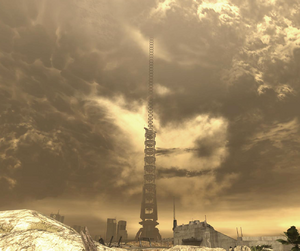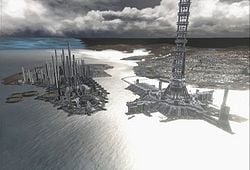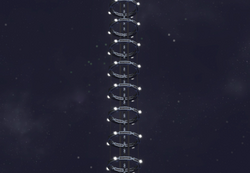Space elevator
From Halopedia, the Halo wiki
| There is more information available on this subject at Space elevator on the English Wikipedia. |

A space elevator, also known as a space tether, is an immense structure which is used to ferry large loads of materials into space. Space elevators generally consist of large structures of carbon nanofiber which span straight up from the ground, thousands of kilometers high, ending at stations in space. Vehicles using the structure derive their power from strands of superconducting material.[1] Space elevators are only known to be constructed by humans since the 24th century.
Introduction[edit]
Space elevators are a common construction by the UNSC, both on Earth and her colonies. While Earth has six space elevators, many planets within the Outer Colonies have more since there is a heavy human reliance on the production and shipment of agricultural and mineral goods from remote worlds. Prior to the Covenant's invasion, the farming colony of Harvest, for example, had seven elevators linked to the orbital station Tiara,[2] while some mineral-rich worlds, such as Reach, had as many as nine.[3] During the events of the Human-Covenant War, many of these elevators were damaged, some seriously, during combat engagements. Of Earth's six elevators, only four remained intact after the Battle of Earth.[4]
Description[edit]
A space elevator is a structure designed to transport and ferry different materials from a planet's surface into space and onto a platform. The base concept of a space elevator consists of a cable attached to the surface on the equator and reaching outwards into space. By positioning it so that the total centrifugal force exceeds the total gravity, either by extending the cable or attaching a counterweight, the elevator stays in place in geosynchronous orbit. Once moved far enough, climbers are accelerated further by the planet's rotation.
The space elevator mainly consists of a tether, an extremely resilient cable that spans from the surface to a point beyond geosynchronous orbit. As the planet rotates, the inertia at the end of the tether counteracts gravity and keeps the tether taut. Vehicles can then climb the tether and escape the planet's gravity without the use of rockets. The engineering of such a structure requires an extremely light but extremely strong material (21st-century estimates required a material ~2 g/cm³ in density and a tensile strength of ~70 Gpa). Such a structure permits delivery of great quantities of cargo and people to orbit, and at costs only a fraction of those associated with conventional means with very little to no danger.
Humans also employ a somewhat similar concept in structures known as skyhooks, platforms suspended in low planetary orbits. Skyhooks are known to be located over Earth and its moon, Luna.[5]
Size[edit]
The space elevator is gigantic, reaching into thousands of kilometers in height. An orbital tether's center of gravity must be above or at a point of geosynchronous orbit above the body it is located on. Because geosynchronous orbit above Earth is quite high, (35,900 kilometers above the surface) the height of the elevator would be twice the distance from the surface to the point of geosynchronous orbit. This gives Earth's orbital tethers (because the same rule would apply to them all) an average height of 70,000 kilometers above the planet's surface.[6]
Structure[edit]
Space elevators vary in size and shape, but they are all typically composed of the same raw material. Meshed together as a complex composite of intertwining nanofibers, these ingredients form a series of massive cords and rings several hundred meters wide. They bind to a grounded set of polycrete anchors larger than most buildings which hold the elevator's structure in place while the planet spins on its axis. The zenith of the elevator, commonly known as the "orbital" or "terminus" is then pulled taut by the planet's rotational inertia, sliding into geosynchronous orbit thousands of kilometers above the planet.[4]
The UNSC utilizes several designs of space elevators. Many space elevators, such as the Mombasa Tether, consist of a single central tether reaching into space, surrounded by additional strands and massive support rings. The lower part of the tether is surrounded by an additional support frame rising several hundred meters from ground level. The Quito Space Tether and Corbulo Academy's space tether utilize a similar design.[7] Harvest's high-capacity orbital elevator system, built in the early 26th century, consisted of seven separate strands of carbon nanofiber, attached to the orbital station Tiara.
A space tether's climber system is often modular, and different types of containers, such as regular cargo containers, maintenance cars, or "Welcome Wagons" used to transport personnel can be used to move on the elevator strands. In heavy-duty cargo elevator systems such as the Tiara, the cargo containers are also compatible with ground-based MagLev train lines and they can be effectively converted into freighters by attaching a propulsion pod to them on the top of the tether.[8]
History[edit]
The earliest concepts of space elevator date back to the end of the 19th century. During the second half of the 20th century and the early 21st century, multiple concepts were proposed, but it was not until almost three hundred years later when the first space elevator would be built. The construction of the first space elevator, the Mombasa Tether, began in 2302. The cities with space elevators, "tether cities" as they came to be called, are often managed by second generation "dumb" AIs. As shown in New Mombasa, space elevators have a significant impact to the importance and economy of the cities they are located in. The cities and their surroundings are usually full of warehouses, to store the massive amounts of cargo transported to and from orbit. As of 2552, Earth had six tether cities, each managed with the help of a Superintendent-class AI.[9][10] Since the construction of Mombasa Tether, space elevators have come to fill number of functions in a variety of locations on Earth's colonies, ranging from transport of industrial or agricultural goods in the colonies to orbital personnel transport in military academies such as Corbulo Academy of Military Science.[7]
Safety[edit]

Due to the size of the space elevator, the safety of such a structure is an obvious concern. Their relatively frail construction makes them an easy target for attacks, and the catastrophic effects of a space elevator's collapse were witnessed multiple times during the Human-Covenant War, when many of UNSC's space elevators collapsed due to the fighting. Depending on the point in which the tether is severed, the collapse of a space elevator will cause varying degrees of large-scale destruction. The tether itself will not cause any significant damage at all, as its lightweight construction allows for air resistance to negate the effects of gravity. Instead, it will be the support structure that surrounds the tether that causes most of the damage, as evidenced by the wreckage strewn across the Tsavo Highway after the collapse of the Mombasa Tether.[11]
If the orbital counterweight is destroyed or the tether is cut near the top, the whole cable will fall, usually wrapping itself around the planet; a space elevator would be able to wrap itself around the Earth at least two times. This happened to Harvest's elevator system when Loki destroyed the Tiara station with a mass driver. The Centennial Orbital Elevator on Earth also collapsed due to the destruction of Station Wayward Rest on top of it.
If the tether is cut halfway up, the upper portion will rise up and remain in orbit while the lower part will drape around the planet. The same will occur if the tether breaks quarter way up. In case the break occurs at or near the anchor point on the planet surface, the whole tether will rise upward and end up in an unstable orbit around the planet. New Mombasa's orbital elevator was cut several hundred meters above the ground anchor due to the damage caused to it by a slipspace rupture backlash. Similarly, the space elevator of Corbulo Academy of Military Science was severed near the anchor by a Covenant corvette's pulse laser.[7]
Due to the safety concerns, tether cities are almost always designed with the possibility of a catastrophe in mind. The cities are often compartmentalized into multiple symmetrical sections, to minimize the death toll and property damage in case anything were to happen to the elevator.[12]
Known space elevators[edit]
- Circinius IV
- A single space elevator at Corbulo Academy of Military Science[7]
- Earth
- Aranuka Space Tether
- Centennial Orbital Elevator
- Mombasa Tether
- Quito Space Tether
- Borneo Space Tether
- Colombo Space Tether
- Malabo Space Tether
- An elevator near Zanzibar Island (post-war)[15]
- Luna has at least one elevator
- Harvest
- 7 space elevators connected to orbital station Tiara[16]
- Reach
- A total of nine space elevators.[3]
- An space elevator on Veszprém[19]
- The Delphi Triple-Strand Network was three of the nine tethers clustered in a single area near New Alexandria[20][21]
- A total of nine space elevators.[3]
- Unspecified colony
Gallery[edit]
Quito Space Tether in Quito, Earth.
Near-final concept of the Mombasa Tether for Halo 3: ODST.
New Mombasa skyline as it appears in Halo 2, with the space elevator and the Covenant assault carrier Solemn Penance.
Thomas Lasky looking upon Corbulo's orbital tether.
Avery Johnson on Harvest with six of the seven Tiara space elevators behind him.
The Nova Austin space elevator under construction in Mindoro, Cascade in the post-war era.
The Borneo Space Tether.
A space elevator on Meridian and one of its orbital docking ports.
An incomplete space elevator and its accompanying facilities near Zanzibar Island.
Closeup of the space tether as viewed from Stonetown.
List of appearances[edit]
- Halo 2 (First appearance)
- Halo Graphic Novel
- Halo: Ghosts of Onyx
- Halo 3
- Halo: Contact Harvest
- Halo 3: ODST
- Halo: Evolutions - Essential Tales of the Halo Universe
- Halo: Reach
- Halo 4: Forward Unto Dawn
- Halo 4
- Halo: Mortal Dictata (Mentioned only)
- Halo 2: Anniversary
- Halo 5: Guardians
- Halo Mythos
- Halo: Retribution (Mentioned only)
- Halo: Legacy of Onyx (Mentioned only)
- Halo: The Television Series Season One
- Halo: Empty Throne (Mentioned only)
Sources[edit]
- ^ Halo: Contact Harvest, page 28
- ^ Halo: Contact Harvest, page 75
- ^ a b Halo: The Essential Visual Guide, page 151
- ^ a b Halo Waypoint, "Space Elevator" article (backup link on Archive.org)
- ^ Halo 4, MJOLNIR Powered Assault Armor/AA variant description
- ^ Wikinomics: Elevator To Space
- ^ a b c d Halo 4: Forward Unto Dawn
- ^ Halo: Contact Harvest, page 67
- ^ Halo: The Essential Visual Guide, page 191
- ^ Bungie.net, Halo 3 ODST : Field Guide - Superintendent (Retrieved on May 25, 2013) [local archive] [external archive]
- ^ Halo 3, campaign level Tsavo Highway
- ^ Halo: Evolutions - Essential Tales of the Halo Universe, "Palace Hotel", page 366
- ^ Halo: The Essential Visual Guide, page 12
- ^ Halo 4, Skyline map description
- ^ Halo 2: Anniversary, multiplayer map Stonetown
- ^ Halo: Contact Harvest
- ^ Halo 4: The Essential Visual Guide, page 159
- ^ Halo 5: Guardians
- ^ Halo Encyclopedia (2022 edition), page 41
- ^ File:Reach E310 Firefight Beachhead03.jpg
- ^ YouTube: E3 2010 Firefight 2.0 Beachhead Gameplay
- ^ Halo: Nightfall, Chapter 2 (Randall Aiken's file)
- ^ Halo 3: ODST Pre-mission Evaluation - Dutch Interview
|
| |||||


















